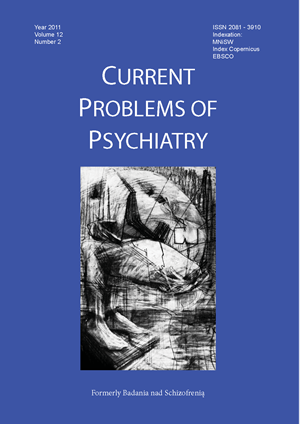Safety of iodinated contrast media in patients with no risk factorsfor thyroid gland disease: thyroid function assessment after computer tomography with the use of iodine contrast media
Keywords:
computer tomography, iodine contrast media, thyroid functionAbstract
Purpose: A prospective study was performed to assess the influence of single, large iodine dose given intravenously to patients undergoing computer tomography living in areas with sufficient iodine supplementation with table salt.
Materials and methods: Thirty one patients with no personal familiar history of thyroid diseases in ages between 22 and 80 years old, were individually given 18.5-55.5 grams of iodine intravenously during computer tomography. Dose of iodine contrast media ranged from 50-150 ml. Evaluated patients had no contact with iodine during the last years. We included patients with no change in thyroid morphology in ultrasound taken by 10 MHz Siemens before trial. In all patients, levels of TSH and FT4 were measured before CT and after 1 and 3 months respectively.
Results: Thyroid hormone levels assessed after one and three months were in normal laboratory ranges. Large, single dose of iodine in contrast media caused no disturbances in assessed thyroid hormone levels.
Conclusions: In adult patients with no morphologic thyroid gland changes and no disturbances of hormonal function, single large dose of iodine is safe.
References
1. Szybiński Z., Delange F., Lewinski A., et al. A programme of iodine supplementation using only iodised household salt is efficient – the case of Poland. Eur. J. Endocrinol., 2001; 144: 331-337.
2. Tedelind S., Larsson F., Johanson C., et al. Amiodarone inhibits thyroidal iodide transport in vitro by a cyclic adenosine 5'-monophosphate- and iodine-independent mechanism. Endocrinology, 2006; 147: 2936-2943.
3. Dohan O., Carrasco N. Advances in Na(+)/I(-) symporter (NIS) research in the thyroid and beyond. Mol Cell Endocrinol, 2003; 213: 59-70.
4. Delange F. Iodine deficiency in Europe and its consequences: an update. Eur. J. Nucl. Med. Mol. Imaging, 2002; Suppl.2: 404-416.
5. Carayon P., Niccoli-Sire P., Lejeune P.J., et al. Guidelines for the diagnosis and monitoring of thyroid disease. Ann. Biol. Clin., 2002; 60: 331-338.
6. Becker D.V., Braverman L.E., Delange F., et al. Iodine supplementation for pregnancy and lactation – United States and Canada: recommendations of the american thyroid association. Thyroid, 2006; 16: 949-951.
7. Eisenberg M., Samuels M., DiStefano J.J. 3rd. L-T4 bioequivalence and hormone replacement studies via feedback control simulations. Thyroid, 2006;16:1279-1292.
8. Hintze G., Blombach O., Fink H., et al. Risk of iodine-induced thyrotoxicosis after coronary angiography: an investigation in 788 unselected subjects. Eur. J. Endocrinol., 1999; 140: 264-267.
9. Skare S., Frey H. Iodine-induced thyreotoxicosis in apparently normal thyroid glands. Acta Endocrinol. (Copenh), 1980; 94: 332-336.
10. Savoie J.C., Massin J.P., Thomopoulos P., et al. Iodine-induced thyrotoxicosis in apparently normal thyroid glands. J. Clin. Endocrinol. Metab., 1975; 41: 685-691.
11. Laurberg P., Jorgensen T., Perrild H., et al. The Danish investigation on iodine intake and thyroid disease, DanThyr: status and perspectives. Eur. J. Endocrinol., 2006; 155: 219-28;
12. Knudsen N., Bulow I., Jorgensen T, et al. Goitre prevalence and thyroid abnormalities at ultrasonography: a comparative epidemiological study in two regions with slightly different iodine status. Clin Endocrinol (Oxf) 2000 ; 53: 479-85;
13. Blattmann H., Reinhardt M., Schumichen C., et al. Thyrotoxic crisis after exposure to iodine. A case with fatal outcome. Radiologe, 1994; 34: 487-490.
14. Del Cerro M.M., Fernandez R.A., Guerta G.L., et al. Thyroid function alterations in children with congenital cardiac disease after catherization with iodinated contrast media. Revista Espaniola de Cardiologia, 2000; 53: 517-524.
15. Gartner W., Weissel M. Do iodine-containing contrast media induce clinically relevant changes in thyroid function parameters of euthyroid patients within the first week? Thyroid, 2004; 14: 521-524.
16. Weber C., Scholtz G.H., Lamesch P., et al. Thyroidectomy in iodine induced thyrotoxic storm. Experimental and Clinical Endocrinology and Diabetes, 1999; 107: 468-472.
17. Lawrence J.E., Lamm S.H., Braverman L.E. The use of perchlorate for the prevention of thyrotoxicosis in patients given iodine rich contast agents. J. Endocrinol. Invest., 1999; 22: 405-407.
18. Van der Molen A.J., Thomsen H.S., Marcos S.K. Effects of iodinated contrast media on thyroid function in adults. Eur. Radiol., 2004; 14: 902-907.
19. Fassbender W.J., Schluter S., Stracke U., et al. Thyroid function after iodine-containing contrast media agent administration in coronary angiography: a prospective study of euthyroid patients. Z. Kardiol., 2001; 90: 751-759.
20. Fassbender W.J., Vogel C., Doppl W., et al. Thyroid function, thyroid immunoglobulin status, and urinary iodine excretion after enteral contrast-agent administration by endoscopic retrograde cholan-giopancreatography. Endoscopy, 2001; 33: 245-252.
Downloads
Published
Issue
Section
License
Copyright (c) 2011 Authors

This work is licensed under a Creative Commons Attribution-NonCommercial-NoDerivatives 3.0 Unported License.


